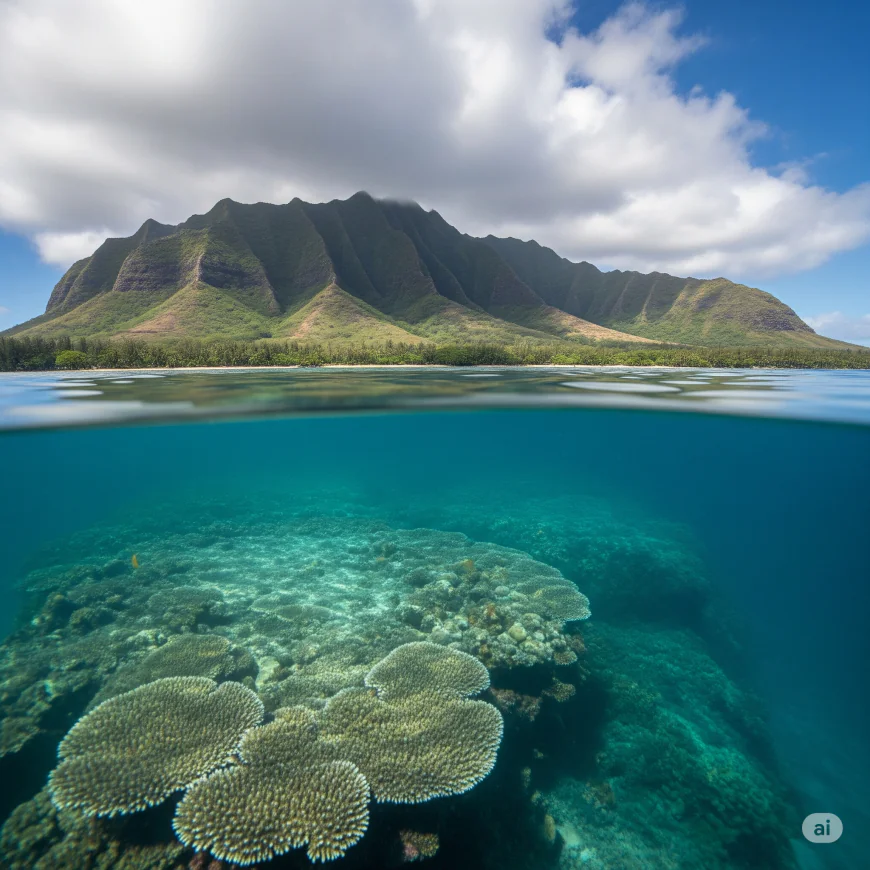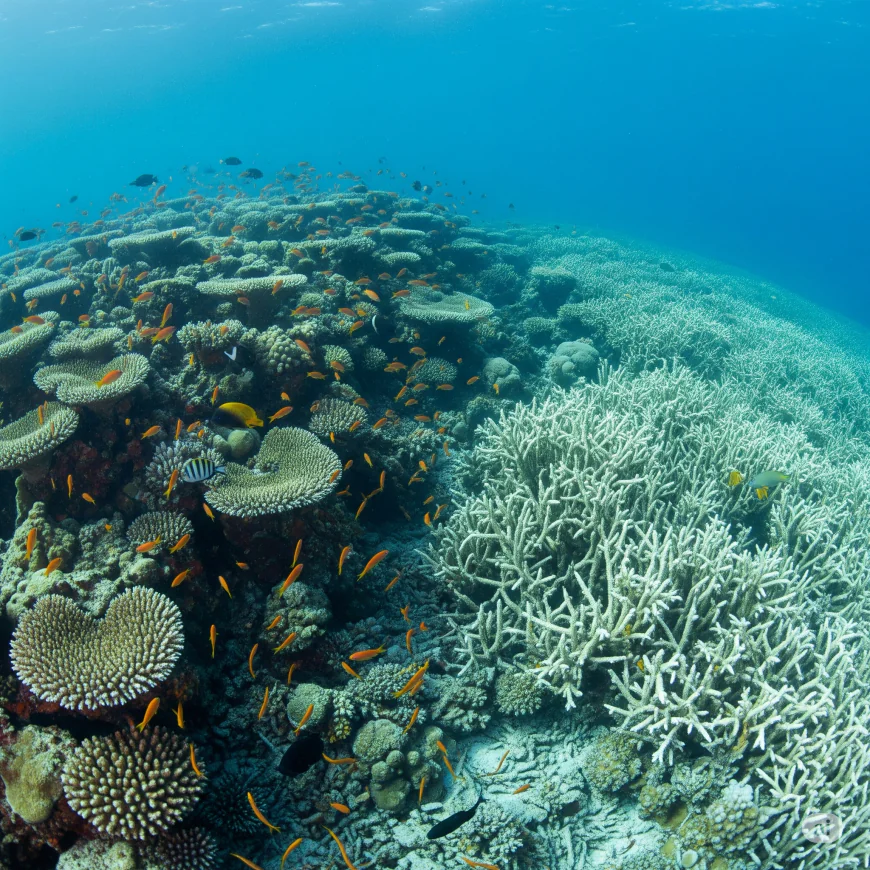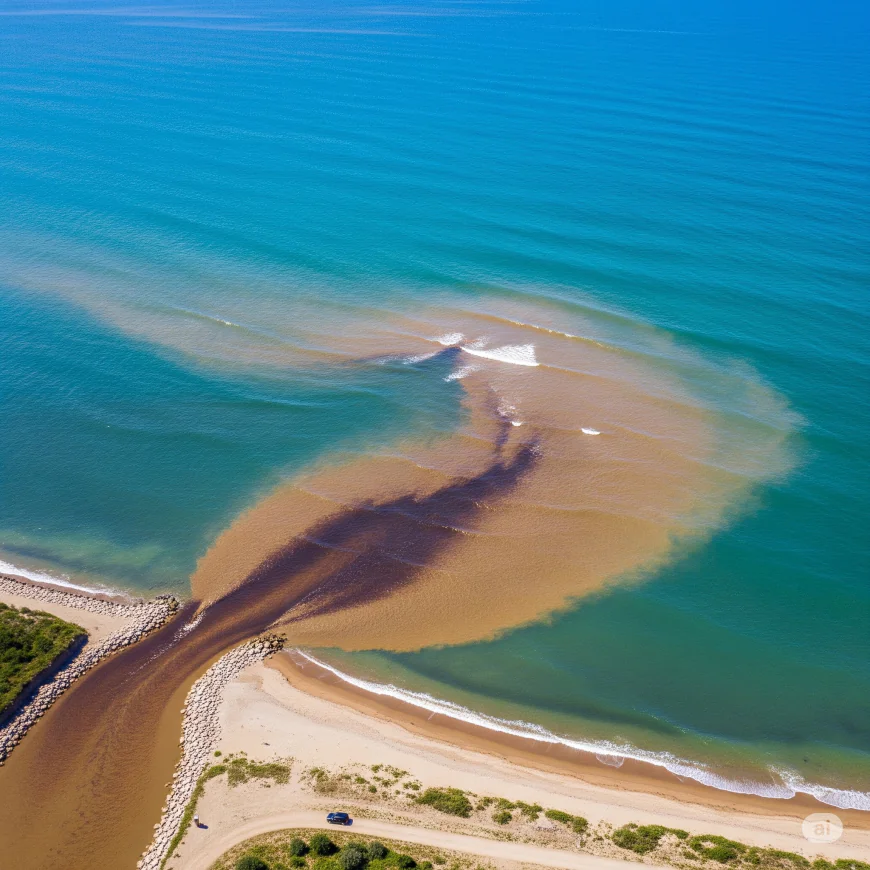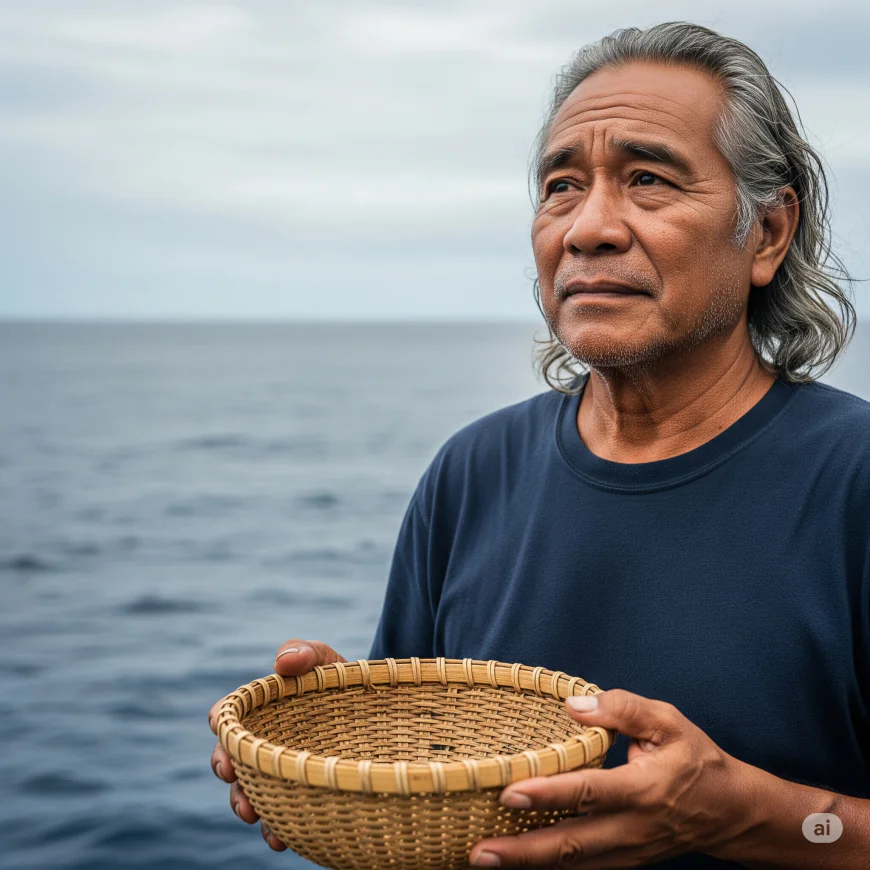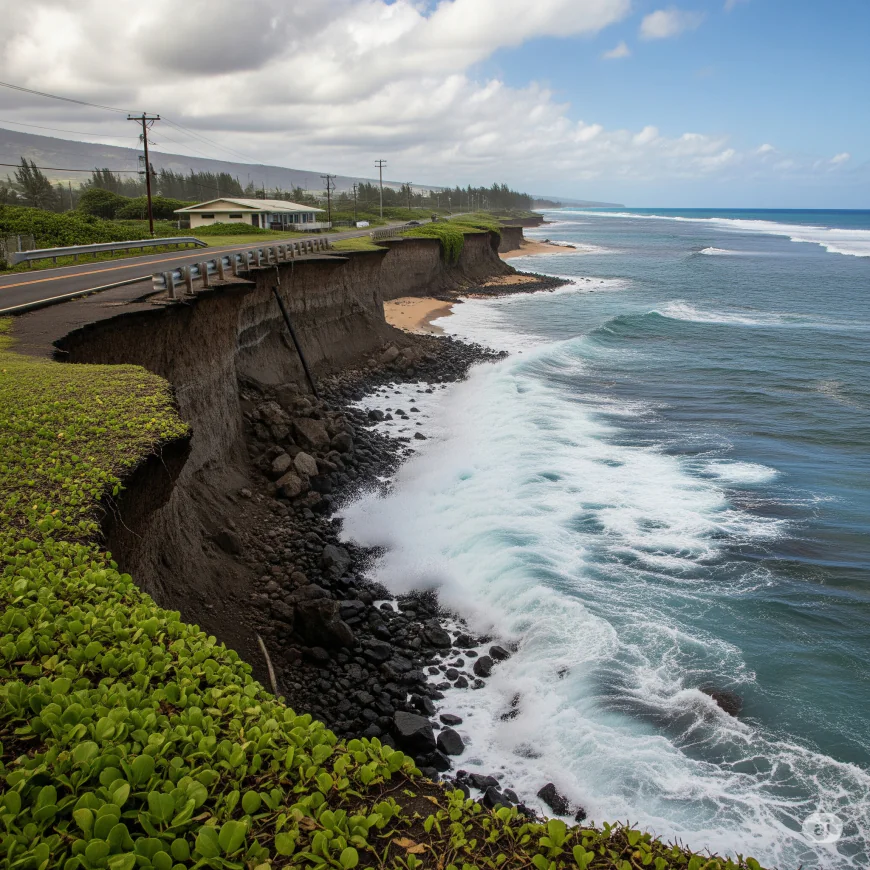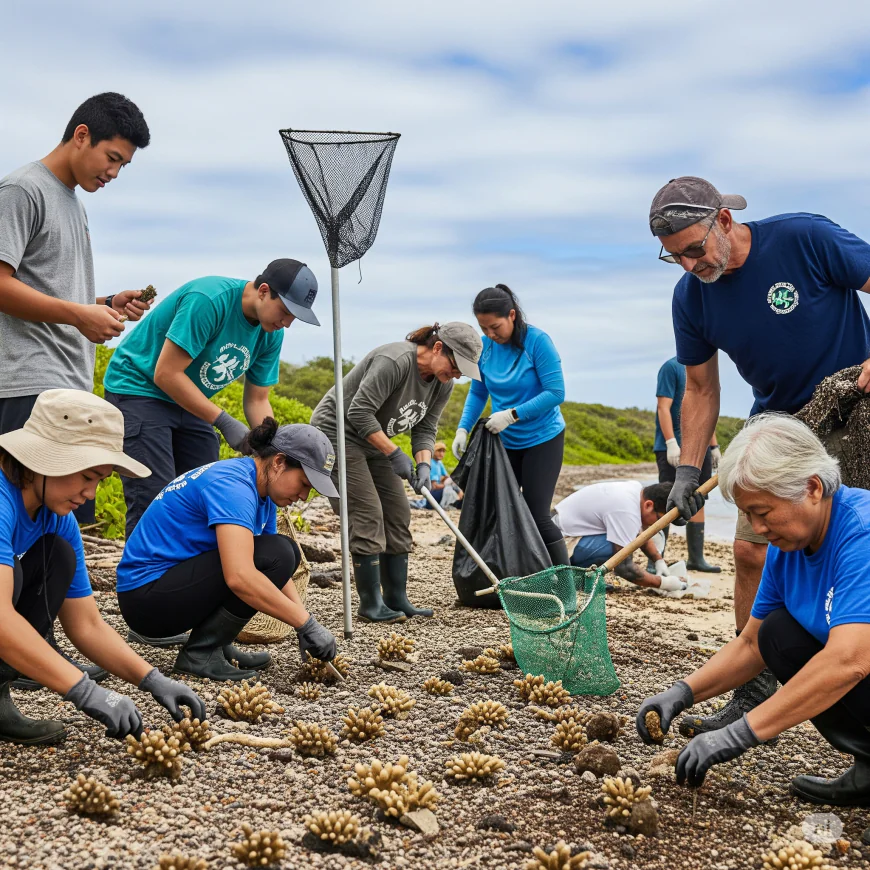The Silent Disappearance: Documenting the Decline of Hawaii's Coral Reefs and Its Broader Ecological & Economic Ripple Effects
Investigate the multi-faceted decline of Hawaii's coral reefs, examining impacts from climate change, pollution, and overfishing on the environment, economy, and Native Hawaiian culture, while proposing integrated solutions for a resilient future.
Hawaii's coral reefs are in serious trouble - and we need to talk about it. These underwater treasures aren't just pretty to look at; they're the backbone of Hawaii's ecology and economy. But right now, they're facing a perfect storm of threats: climate change, pollution running off from the land, too many people doing harmful things, and straight-up physical damage.
Here's the thing - when these reefs suffer, everyone suffers. Hawaii's tourism industry? It takes a hit. Local fishing communities? They struggle to make ends meet. And it doesn't stop there. We're seeing more problems with clean water becoming scarce and contaminated.
But perhaps the most heartbreaking impact hits Native Hawaiian communities. These reefs aren't just ecosystems - they're sacred spaces tied to centuries of culture and tradition. When the reefs decline, it tears at the spiritual fabric of these communities, leading to real mental health struggles and forcing families to leave their ancestral homes.
The path we're on right now? It's not sustainable. We need a game plan that connects all the dots - one that sees how environmental damage, economic hardship, and social challenges are all linked together. Only then can we protect Hawaii's future and the incredible reefs that make these islands so special.
Hawaii's Coral Reefs - A Vanishing Treasure
Ecological Significance and Unique Characteristics
Hawaii's coral reefs aren't just pretty to look at - they're absolutely vital ecosystems that give countless marine species a place to live, eat, and raise their young. We're talking about everything from tiny invertebrates to massive predatory fish. These underwater wonderlands are biodiversity hotspots, home to an incredible array of marine life, including bright yellow tangs, mysterious moray eels, sea urchins, starfish, and octopuses.
But here's the thing - it's not just about the flashy corals and cool fish. The real heroes keeping these reefs healthy are algae and seagrasses. Algae work like underwater solar panels, turning sunlight into energy and pumping out the oxygen we need. Meanwhile, seagrass meadows act like underwater nurseries where baby fish and other creatures can hide and find plenty to eat. These grasses also keep the ocean floor stable, stop erosion, and help keep the water crystal clear by catching sediment and soaking up extra nutrients.
The relationships in these reef ecosystems are pretty amazing. Take coral polyps and algae - they've got this perfect partnership where algae make food through photosynthesis, and corals give them a safe home plus nutrients. Hawaii's isolation has created something special, too. About 25% of the species in the Papahānaumokuākea Marine National Monument (PMNM) exist nowhere else on Earth. In the Monument's northern atolls, that number jumps to an incredible 90-100% for some fish populations. That makes PMNM one of the world's most important marine biodiversity treasures.
Now, here's what makes Hawaii's corals unique - they grow incredibly slowly, just 1-2 centimeters per year. Compare that to corals in the South Pacific and Caribbean that grow 10-20 centimeters annually, and you'll see why we need to protect them. The PMNM covers 3.5 million acres of coral reef, which is 70% of all U.S. coral reefs. These reefs are among the last places on Earth where big predators like ulua (trevally jack) and sharks still rule, showing us what a healthy ocean food web should look like.
Historical Context of Reef Health and the Onset of Decline
Hawaii's coral reefs have been in serious trouble for decades, and things really started going downhill when development took off in the 1950s. The numbers are shocking - some areas have lost up to 60% of their coral cover over the years. And it's not just the corals suffering. Near-shore fish populations have taken a massive hit, too. Between 1900 and the mid-1980s, catch rates dropped by almost 80%. These trends paint a clear picture: we've been damaging Hawaii's marine ecosystems for a long time, and the changes have been devastating.
The Ecological Decline: A Fragile Ecosystem Under Threat
Drivers of Degradation
Hawaii's coral reefs are taking a beating from both nature and human activity, and the damage is speeding up faster than we'd like to admit.
Climate Change Impacts
Here's the deal: ocean warming and acidification are the biggest threats our coral reefs face globally. You know how the ocean absorbs carbon dioxide from the air? Well, that's turning our seawater more acidic, making it tough for corals and shelled creatures to build and maintain their calcium carbonate skeletons.
At the same time, warmer ocean temperatures are causing more frequent and severe coral bleaching. Hawaii saw this firsthand in 2014 and 2015 - we're talking "unprecedented amounts of bleaching" that killed off 50% of reefs in some spots. Can you believe that 80% of Oahu's Kane'ohe Bay corals bleached in 2014?
It gets worse. Scientists predict coral bleaching will happen every single year by 2040. The IPCC warns that even if we limit global warming to 1.5°C, we'll still lose 70-90% of coral reefs worldwide - and that damage? It's irreversible.
Here's how it works: we burn fossil fuels, releasing massive amounts of CO2. The ocean soaks up much of this CO2, which makes the water acidic and warm. This double whammy stresses corals so much they kick out their symbiotic algae (that's the bleaching part). Without these algae, corals become weak, get sick easily, and often die. It's a direct line from our greenhouse gas emissions to Hawaii's dying reefs.
Land-Based Pollution
Pollution from land is seriously threatening Hawaii's coral reefs. When it rains, all that sediment from coastal development, city streets, forests, and farms washes into the ocean, literally smothering corals. This gunk blocks their ability to feed, grow, and reproduce.
Then there's the nutrient problem. Nitrogen and phosphorus from farm fertilizers, sewage (including from treatment plants and septic systems), and animal waste are creating seaweed explosions. These aggressive algae grow like crazy, outcompeting and choking out corals. Plus, all these extra nutrients make corals more likely to bleach.
Toxic chemicals are another nightmare. We're talking metals, organic chemicals, and pesticides from factories, sunscreens, city runoff, farms, and landfills. These toxins damage coral DNA, mess with reproduction, stunt growth, and cause bleaching. Hawaii banned sunscreens containing oxybenzone and octinoxate in 2021 because of this.
But here's the real kicker: cesspools. Hawaii has about 88,000 of them, dumping 53 million gallons of raw sewage into waterways every single day. This untreated waste seeps into groundwater and flows straight to the ocean, bringing dangerous levels of nutrients, bacteria, and pathogens. On Hawaii Island, this sewage pollution has caused fish populations to crash, coral disease to spread, bleaching to increase, and even made people sick.
This isn't just a few isolated problems - it's a complete breakdown in how we manage wastewater, plan land use, and run farms. The sheer amount of sewage from cesspools and runoff from farms and cities shows we need major infrastructure upgrades and new regulations, not just quick fixes.
Overfishing and Unsustainable Practices
When we take fish faster than they can reproduce, we're overfishing - and it's destroying both the fish populations and the coral habitats they live in. This creates a domino effect that hurts local economies depending on healthy reefs.
Why is this happening? Our population's growing, we want more seafood, fishing tech has gotten super efficient, and we're not managing or enforcing regulations well enough.
Some particularly harmful practices include fishing in nursery areas (taking baby fish before they can grow up), leaving lost traps and nets that damage reefs, using gear that catches everything (including the herbivorous fish that keep algae in check), and targeting fish during spawning when they gather in huge, easy-to-catch groups.
Recent studies show we're likely overfishing 11 reef fish species in the main Hawaiian Islands, including important ones like kala (unicornfish), ulua (giant trevally), surgeonfish, and parrotfish. With fewer carnivorous fish around, sea urchins have exploded in places like Hōnaunau Bay. These urchins are grinding away coral skeletons at alarming rates.
Here's what's happening: we've removed too many top predators (jacks, sharks) and herbivorous fish (parrotfish, surgeonfish). Now sea urchins and algae are taking over. The urchins physically destroy cora while algae smother it, creating a vicious cycle that speeds up reef destruction and throws the whole marine food web out of whack.
Physical Damage
Hawaii's reefs face constant physical abuse from human activities. People touch and stand on corals, crushing delicate polyps and stopping growth. Careless boat anchoring causes major damage. Coastal development, dredging, and quarrying destroy reef areas. Some fishing methods, like blast fishing, can wipe out entire reef sections.
Boat groundings are a huge problem - over 2,100 happen yearly in U.S. coastal waters, with about 440 boats sinking annually. These accidents cause massive, long-lasting damage, and coral reefs recover incredibly slowly.
Marine debris is another chronic threat. Old fishing gear (nets, lines, traps) and plastic pollution snag on corals, blocking sunlight, tangling and killing reef creatures, and breaking coral structures.
Think about it: every tourist touching coral, every careless fin kick, combined with boat groundings and constant marine debris, plus heavy tourism and ongoing coastal development – it all adds up. This relentless physical assault prevents Hawaii's slow-growing reefs from recovering and makes them weaker against other threats.
Other Stressors
As if that wasn't enough, Hawaii's reefs face even more challenges. Invasive species, especially aggressive algae like Gorilla ogo, muscle out native corals and algae for space and resources.
The August 2023 Maui wildfires created a whole new threat. Runoff from burned areas carried ash, particles, and toxic materials into coastal waters, including copper from boat paint and industrial chemicals like PCBs and PAHs. While the reefs looked okay at first, chemical tests confirmed these pollutants were present. We're worried these toxins are building up in the food chain, but we don't really know the long-term effects yet.
These wildfires showed us something scary: urban fires can send new chemical pollutants into the ocean through runoff. It's another example of how climate change (drought, hurricane winds) creates unexpected threats to coastal ecosystems, with consequences we're only beginning to understand.
Cascading Ecological Impacts
When Hawaii's coral reefs decline, it sets off a chain reaction that threatens entire marine ecosystems.
Biodiversity Loss and Habitat Degradation
Coral reefs are like underwater cities, providing homes, food, and nurseries for countless marine species. As reefs degrade, all these creatures lose their homes, causing fish populations to crash and marine diversity to plummet.
Get this: coral reefs cover less than 1% of the ocean floor but house nearly 25% of all ocean species. When reefs decline, we can lose 20-40% of species diversity in those areas. Hawaii's situation is especially worrying because many species here exist nowhere else on Earth - when they're gone, they're gone forever.
Disruption of Marine Food Webs and Ecosystem Balance
Overfishing throws everything off balance. When we remove too many herbivorous fish, algae grow wild and smother corals. Take out too many carnivorous fish, and sea urchins explode in numbers, physically destroying reefs through excessive erosion.
Ocean acidification makes things worse by preventing plankton and shelled creatures from forming their structures properly. Since these organisms form the base of the marine food web, their struggles affect everything up the chain.
Loss of Natural Coastal Protection and Increased Vulnerability to Hazards
Coral reefs are nature's breakwaters, absorbing wave energy and protecting our shores from flooding, erosion, property damage, and even saving lives. Without healthy reefs, our coastlines become sitting ducks for erosion and severe weather.
Degraded reefs can increase coastal erosion by 30-70% and let storm surges penetrate 50-100% further inland. Hawaii's already feeling this - we've lost 13 miles of beaches to seawalls, and 70% of our beaches face erosion threats.
Here's the terrible irony: as reefs degrade, they can't protect our coasts. This leads to more erosion and flooding, which sends more sediment and pollution into the ocean, further damaging the remaining reefs. It's a downward spiral that's picking up speed.
Economic Ripples: How Hawaii's Dying Reefs Are Hitting Our Wallets
When Hawaii's coral reefs suffer, it's not just an environmental heartbreak - it's an economic earthquake that shakes every corner of our island economy. Let's dive into how the underwater crisis is creating waves that could sink our long-term prosperity.
Tourism Takes a Hit
Here's the thing: coral reefs aren't just pretty to look at - they're the backbone of Hawaii's tourism industry. Get this: 60% of our tourist income comes directly from visitors who want to experience our reefs. We're talking about $304 million in annual revenue from reef tourism alone. Overall, our nearshore reefs pump about $800 million into the economy every year - that's nearly 10% of all tourism revenue!
But here's where it gets scary. When reefs become severely degraded, tourist visits can plummet by 80-90%. That means massive job losses and local businesses watching their revenue dry up. Property values near damaged reefs? They can drop by up to 30% as the natural beauty and protection disappear.
Take Kihei, Maui, for example. Those nasty algal blooms alone cost over $20 million annually - including $10.8 million in lost hotel and rental income and $9.4 million in depressed property values (in 2002 dollars). Maui County also shells out an extra $200,000 every year just to clean up the mess on beaches. Here's the crazy paradox: tourists flock here for our pristine reefs, but unmanaged tourism is destroying them through physical damage, pollution, and coastal development. We're essentially killing the golden goose – chasing short-term profits while destroying the natural assets that bring in long-term revenue. It's a classic "tragedy of the commons" unfolding right before our eyes.
Our Fisheries Are Failing
Coral reefs are essential for our nearshore fisheries – they're where fish live, breed, and feed our coastal communities. But here's the sobering reality: 75% of nearshore fisheries in the Main Hawaiian Islands are depleted compared to the protected Northwestern Hawaiian Islands. Many commercial species now yield just 1% of their historical catches. When reefs degrade, fish populations can crash by 60-80%.
Hawaii's nearshore fishery is worth between $10.3 million and $16.4 million annually, providing over 7 million meals per year. Most of this comes from non-commercial fishing. As local fish populations decline and environmental damage hurts agriculture, we're forced to rely more on imported food – a real threat to our food security.
Look at Maui's water shortages – they've directly caused vegetable prices to spike, pushing locals to buy more imported produce. When our reefs fail and fisheries collapse, we don't just lose money. We lose our traditional ways of life, our cultural connections to the ocean, and our ability to feed ourselves. That's a crisis on multiple levels.
Our Coastlines Are in Danger
Here's something most people don't realize: coral reefs are like natural seawalls, protecting our shores from flooding. They save Hawaii an estimated $836 million annually in prevented damage. But if we lose just 1 meter of reef height, the 100-year floodplain would expand by 33 km², putting 9,200 more people and $1.3 billion in property at risk.
Coastal erosion is already threatening homes, roads, and critical infrastructure. The Hawaii Sea Level Rise report projects a jaw-dropping $19 billion in lost property value by 2100. Waikiki – which generates $5 billion annually – faces serious groundwater flooding that threatens $5 billion in real estate and 30 miles of roads. And here's the kicker: seawalls won't stop it. We'll need creative solutions to handle standing water in the streets.
The costs are staggering. The Honolulu Board of Water Supply needs $300 million just to update 76 miles of pipeline vulnerable to seawater corrosion. The Department of Transportation? They're looking at $15 billion to raise or relocate 15% of our highways.
But that's just the tip of the iceberg. Think about skyrocketing insurance premiums, some coastal areas becoming uninsurable, disrupted services, and the massive drain on our state budget. We're facing a compounding financial crisis that we're barely beginning to understand, let alone budget for.
Water Crisis: The Perfect Storm
Hawaii's freshwater supply is in serious trouble, and it's connected to everything else we've talked about. We get 99% of our drinking water from underground aquifers. These volcanic aquifers are productive but limited – they're surrounded by and floating on saltwater.
Saltwater intrusion is a natural process, but we're making it much worse. When we pump too much groundwater, we lower the freshwater table, letting denser saltwater push inland. Sea level rise makes this even worse by lifting the water table and pushing salty water further inland.
We're already seeing the impacts. Most freshwater lenses have been shrinking over the past 40 years, especially in developed areas where they're rising at 1 meter per year. On Oahu, pumping from the Waiawa and Hālawa Shafts has created expanding zones of brackish water. In Lahaina, Maui, many wells already exceed safe chloride levels for drinking water, and water use is projected to increase 67% by 2035.
Sea levels could rise 8 inches by 2050 and 3.5 feet by 2100 – potentially up to 8 feet in worst-case scenarios. By 2050, we're looking at 150 high tide flood days per year. After 2030, we'll have less groundwater we can safely extract.
But it's not just about salt. Polluted runoff from cities, farms, and especially cesspools dumps sediment, nutrients, bacteria, and toxic chemicals into our waters. In areas like Honolulu and Waikiki, 86% of active cesspools are already flooded by groundwater – that means raw sewage is entering our coastal waters. Even slightly salty water can cause hypertension, stomach problems, weakened immunity, kidney stones, and cancer.
The price tag? Honolulu needs $300 million for pipeline updates alone. A new desalination plant costs $204 million plus $2.7 million in annual operating costs. While direct potable reuse might be cheaper than buying water, it requires high-tech systems and expertise that smaller communities can't afford.
Our farmers are feeling it. Oahu taro farmers are watching their water tables drop dramatically, leaving them with a fraction of the water they need. Yields are down, costs are up, and food security is threatened. When saltwater floods farmland, it can take two years to flush the salt before crops can grow again.
Hawaii's unique volcanic geology – with its porous lava flows and underground barriers – makes our water especially vulnerable. Our freshwater floats on saltwater, and that balance is breaking down. We're facing a perfect storm of natural vulnerability and human pressure that demands immediate, comprehensive action.
Cultural and Social Fabric: When Identity and Well-being Start to Crumble
Hawaii's coral reefs are dying, and it's not just an environmental problem. The ripple effects are tearing at the cultural and social fabric of local communities—especially for Native Hawaiians who've called these islands home for generations.
Native Hawaiian Culture Takes a Direct Hit
For Native Hawaiians, the connection to their land (ʻāina) and ocean isn't just cultural—it's spiritual. Think about it: their creation story begins in the sea, with the coral polyp as the first living being. So when coral reefs die, it's like watching a piece of their soul disappear.
The wounds run deep. After colonization stripped away their land, overthrew their kingdom, and banned their language and customs, Native Hawaiians already carry what they call kaumaha—a heavy, crushing sadness. Now, dying reefs are making things worse by destroying the very practices that kept their culture alive.
Traditional fishing? It's getting harder when there aren't enough fish left. Gathering limu (algae) for food and medicine? That's disappearing too, thanks to urban sprawl, overharvesting, invasive species, and climate change. These aren't just hobbies—they're lifelines to ancestral knowledge that's been passed down for centuries.
Here's what's heartbreaking: elders can't teach the next generation how to fish with nets or manage resources sustainably when there's nothing left to manage. The old ahupuaʻa system—which brilliantly connected mountains to sea and kept everyone fed—collapsed after the Great Mahele of 1848. Without healthy reefs and ecosystems, it's nearly impossible to pass on values like pono (living in balance) and mālama (caring for the land) to the kids. The result? Young Native Hawaiians feel cut off from their roots.
The Mental Health Crisis Nobody's Talking About
Hawaii's environmental and economic struggles are taking a massive toll on mental health, especially among young people. When you can't afford stable housing, anxiety and depression follow. Kids in unstable homes face higher risks for everything—poor physical health, mental health issues, even suicide. For Native Hawaiian young adults, the trauma of colonization makes things worse, though staying connected to their culture does offer some protection.
The numbers are staggering. Native Hawaiian and Pacific Islander youth make up a huge chunk of the homeless population. Among them, 57% struggle with major depression and 56% with anxiety disorders. But here's the kicker—they're way less likely to get help.
The Maui wildfires showed just how vulnerable these communities are. More than half of kids aged 10-17 screened positive for depression afterward. Thirty percent reported anxiety, and nearly 45% showed PTSD symptoms. Meanwhile, 41% of adults are still stuck in temporary housing, which only adds to the stress.
Getting mental health care in Hawaii? Good luck. By late 2024, 39% of young adults couldn't get the help they needed. Why? Providers are booked solid (79% cited this), and it's too expensive (49% said so). Discrimination keeps others from even trying. Hawaii ranks 49th in the country for treating youth depression—75% of kids who need help aren't getting it. That's 12,000 young people suffering in silence.
Living with constant housing stress and poverty doesn't just make you feel bad—it rewires your brain. Kids growing up this way often develop PTSD, anxiety, and depression that can last a lifetime.
Why Everyone's Leaving Paradise
Hawaii's the most expensive state in America, with homes averaging $850,000. Only one in four households can afford to buy at that price. When you add up housing, food, healthcare, and getting around, most working families simply can't make it work.
So they leave. In 2023, we saw something interesting—nearly twice as many Hawaii-born folks came back compared to those who left. Most were young adults aged 25-44. But don't get too excited—the high cost of living is still pushing people away in droves.
Where are they going? Young, educated workers are heading to the West Coast (California, Washington, Oregon, Nevada, Arizona, Colorado) and the South (Texas, Florida, Georgia, Virginia). They're chasing better pay and way cheaper housing.
This "brain drain" is devastating Hawaii's future. Without young workers, the economy struggles. Families get torn apart. Kids lose their schools and friends. Communities of color get hit the hardest. And when local leaders keep saying young people need to leave for better opportunities, it becomes a self-fulfilling prophecy. Why invest in creating opportunities at home if everyone believes the future is elsewhere?
Conclusions and Recommendations
Summary of Crisis
Hawaii's coral reefs aren't just dying in isolation—they're flashing a bright red warning sign about a much bigger crisis that's hitting the state's environment, economy, and communities hard. When you look at how climate change, pollution from the land, unsustainable fishing, and physical damage all work together, you see a vicious cycle that's making everything worse across the board. Our deep dive into this issue shows we desperately need solutions that connect all the dots instead of treating each problem separately. Think about it: tourism's bringing in money but hurting the reefs, local food systems are getting shakier, coastal infrastructure repair bills are skyrocketing, and we're facing a freshwater crisis. It's all connected. And let's not forget—Native Hawaiian communities are bearing the heaviest burden, losing their cultural heritage and facing mental health challenges while being pushed out of their ancestral homes.
Recommendations
So how do we tackle this massive challenge and build a stronger Hawaii? Here's what needs to happen:
Connect Land and Sea Management: We've got to stop pretending what happens on land stays on land. Everything flows downhill to the ocean, right? That means cracking down on wastewater problems—especially getting rid of those old cesspools fast—and upgrading sewage systems across the state. We also need farmers to use methods that keep chemicals and soil from washing into the sea.
Fight Climate Change on Two Fronts: While the world works on the big picture, Hawaii's got to keep pushing toward net-negative emissions by 2045. That means more solar panels, wind turbines, and energy-efficient buildings. But here's the thing—we also need to prepare for what's already coming. Natural solutions like bringing back wetlands, native forests, and traditional fishponds can protect our coasts and save water. With sea levels expected to rise 8 inches by 2050 and 3.5 feet by 2100, every new building project needs to factor that in. Sometimes, that'll mean moving away from the most vulnerable shorelines.
Save Our Fish and Fix Tourism: Our reef fish need a break to bounce back. That means enforcing fishing rules, especially for the herbivores and predators that keep reefs healthy. We've also got to teach both tourists and locals how to enjoy the ocean without damaging it. Tourism should help protect reefs and support communities, not just chase endless growth.
Secure Our Water Future: We need to get creative about water—recycling wastewater for things like irrigation, and maybe even desalination where it makes sense (though that's expensive and complicated). Keeping tabs on our groundwater is crucial to prevent saltwater from creeping in. And those cesspools near the coast? They've got to go—they're poisoning both our drinking water and the ocean.
Put Native Hawaiians First: It's time to face the historical trauma and ongoing discrimination Native Hawaiians deal with, and honor their deep connection to these lands and waters. Traditional Hawaiian knowledge combined with modern science could be the key to saving our reefs. We also need serious investment in affordable housing that keeps local families here, not pushed out by rising costs.
Build Better Mental Health Support: Our communities need more mental health services that work for them—especially for young people and families struggling to make ends meet. These services have to understand and respect Native Hawaiian and Pacific Islander cultures and the trauma many have experienced. For homeless youth and families, wraparound programs that tackle housing and mental health together are essential.
Concluding Thoughts
By weaving together environmental protection with smart social and economic policies, Hawaii can face down the coral reef crisis and build something better—a future that's resilient, fair, and sustainable for everyone who calls these islands home. This isn't just about fixing pipes or protecting fish. It's about understanding that healthy reefs, healthy communities, and healthy cultures all depend on each other. When we talk about "culturally sensitive water resources" and using a "Native Hawaiian framework" for managing land and sea, we're recognizing that the old ways often hold wisdom for today's challenges.
Here's what's exciting: these recommendations show we're finally getting that good data, and community voices need to work together. Sure, we need "real-time data systems to guide public policy," but that data has to shape policies that communities want and will support. You can't just throw science at a problem—you need fair solutions that make sense to the people living with them every day. When we bring together solid science and real community participation, that's when we'll build a Hawaii that can weather any storm.



